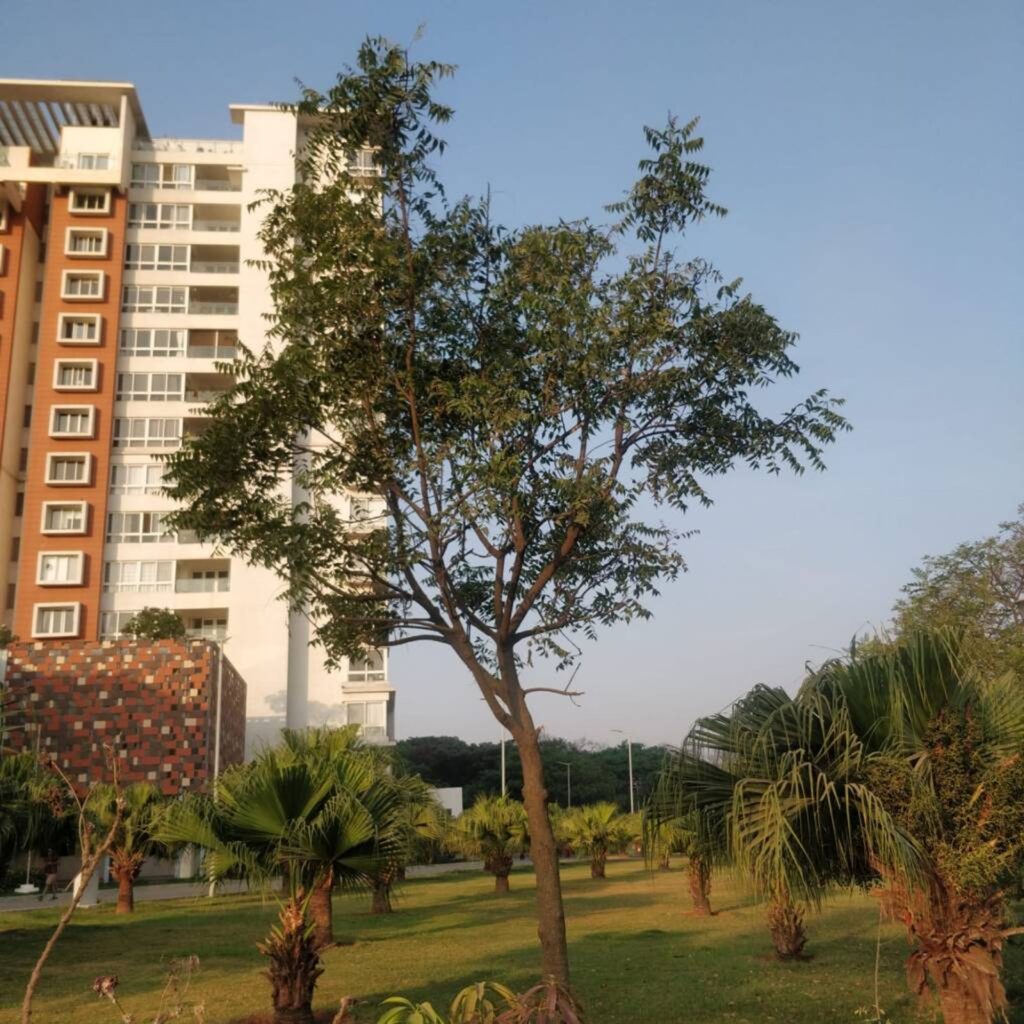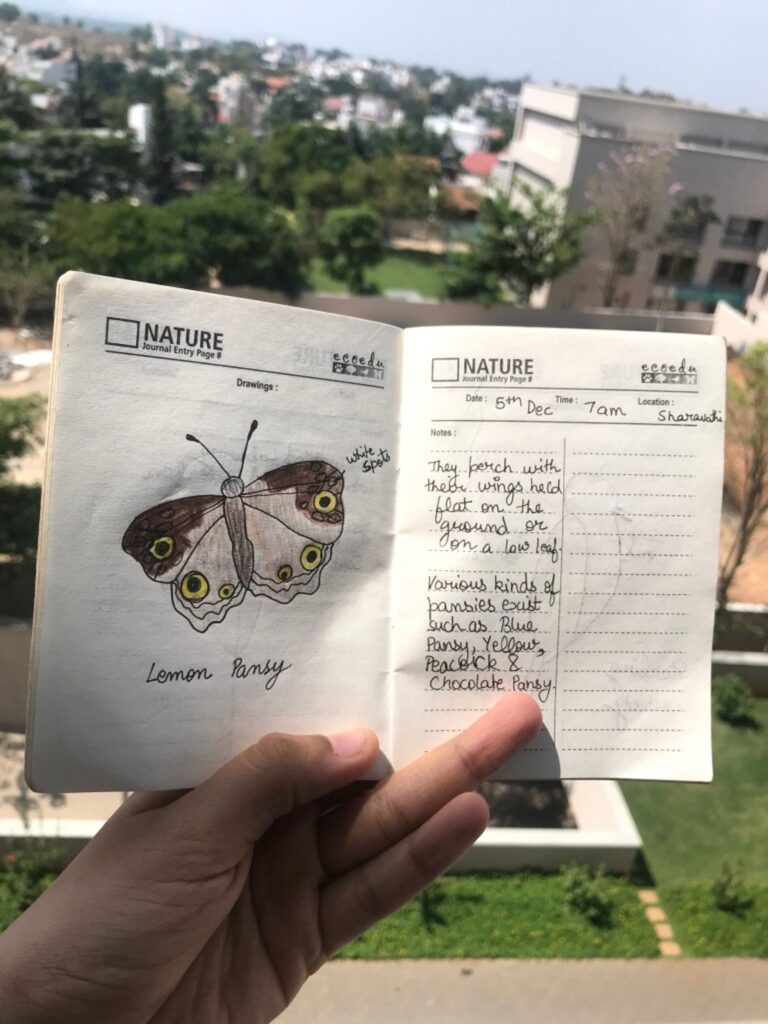Kindness Nature Walk @ Embassy Pristine, HSR
Hello Readers!
How have you been?
Let me tell you about something exciting that happened this month. I conducted a nature walk for The Kindness Club of Embassy Pristine in Bangalore. It was a part of their project for the month of April. The EP Kindness Club was started to inculcate universal values in their young members. They conduct an event almost every month to work on values like empathy and kindness towards one and all. They live in a very green campus and they thought it would be good to introduce the children to the biodiversity on display within the complex and also get them to appreciate Mother Earth and understand the responsibility they have to protect and look after it.
The day I went there was itself a very lovely day for a nature walk. We had a 25 children in total, along with 6 very helpful parent volunteers. In this article, I’d like to give you a glimpse of how the walk was, some things I shared with the kids and the best sightings for the day.
Contents
- Venue : Embassy Pristine
- Good Spotting
- Little Learners need their Field Notes
- Trees: Frangipani TreePink Trumpets of BangaloreBamboo TreeStrangler Figs
- Jumping Spider
- Insects: Common Jay Butterfly Weaver Ants & their Incredible Tree Nests
- Nature Yoga
- A Testimonial by Beena ji
Venue : Embassy Pristine CHS
Location : Suncity Apartments Ln, Ibbaluru, Bellandur, Bengaluru, Karnataka 560102
Picture Courtesy : Resident Meethu J




I was very happy to visit this housing society, which is filled with a wide variety of trees and plants. They have put a lot of thought into the landscaping and ‘green planning’. My host, Meethu, was kind enough to give me a tour of the circuit, where she pointed out trees such as Butterfruit(Avocado), Eucalyptus and the Cancer-Healing tree. For our purposes, we used the amphitheatre area and a play space with next to the tennis ground. The campus is right next to Bellandur Lake, which was dried up at the time when I was visiting, and also shares boundary with an Army Shooting Range.
The Programme
We put the children in 6 nature-themed groups – Bird, Spider, Chameleon, Tree, Butterfly and Frog, and assigned a parent volunteer as a group leader.

Good Spotting
The best thing about going on a nature walk with a group of people is the great variety of things you all can discover together. And there is so much more learning that happens in a group. They say, two pairs of eyes is better than one, so how about 32? Haha. The children were asked to share their observations with us. If someone pointed out at something interesting, as adults we would be sure to encourage the child’s effort by saying –
Now that’s a good spotting!

What have the kids spotted?
And in this way, the kids brought many wonders to us, which would have escaped my notice alone. We saw a honeybee, a hornet, interesting flowers, leaves and more.
Little Learners need their Field Notes


When we go out on nature walks, we try to cultivate a spirit of learning and observation in the learners. In the field, we are sure to run into interesting and beautiful sights, modelled by Mother Nature, and you will need a place to keep your observations.
At the beginning of the walk, we gave each child their personal copy of Field Notes. I showed them an example of what a nature guide would do by displaying pages from my Field Notes, where I had observed a Lemon Pansy butterfly. If they saw something interesting on today’s walk, they could take down visual notes and store it for later reference.
The benefit of keeping notes is that a lot of times you might see things that you do not know about. Perhaps you see an insect, and you see the interesting orange colouration on it, but you do not know what it is and how to find more about it. Your notes will help you. You can describe the unique visual characteristics to an expert and find out more about your sighting later.
These Field Notes are wonderfully designed and provided to us by Eco Edu Consultants. Individuals who are doing consistent and impactful work in the field of nature education.
Trees
Frangipani Tree

We crossed the Frangipani tree on our track, where I asked the group to pick up the flowers and smell them. ‘Aren’t they so sweet-smelling?’ Frangipani has been grown for centuries in India, where it was first brought by travellers from the Atlantic islands and other tropical regions. It has served as an avenue tree due to its ornamental beauty. One of the most distinctive features of the Frangipani Tree is its beautiful and fragrant flowers. The flowers are large and showy, with five petals arranged in a spiral pattern. They come in a variety of colors, including white, yellow, pink, and red, and often have a yellow center. The flowers bloom in clusters at the end of branches and emit a sweet, tropical fragrance.
The Pink Trumpets of Bangalore

P.C – Meethu J
Have you seen these across the city? They are the Pink trumpet trees, also known as Tabebuia rosea. They are commonly mistaken for Cherry Blossom trees from Japan, but the two trees are very distinct. These trees were introduced to India from their native region in Central and South America. They were likely brought to India as ornamental trees due to their beautiful pink flowers. Over time, they have become naturalized in many parts of India, including Bangalore, and are now commonly found growing along roadsides, in parks, and in gardens. Pink trumpet trees are known for their hardiness and adaptability, and they are able to thrive in a wide range of soil and climatic conditions. Overall, pink trumpet trees are a beautiful and beneficial addition to the Indian landscape.
Bamboo Tree

Speaking about the Bamboo Tree
Bamboo is a fascinating plant that has been used by humans for centuries. It is actually a type of grass, but due to its woody, tree-like appearance, it is often referred to as a bamboo tree. It is one of the fastest-growing plants in the world and can grow up to 91 cm (35 inches) in a single day! This makes bamboo an incredibly sustainable resource, as it can be harvested and replanted quickly, meaning that it can be used for a wide range of purposes. Bamboo is lightweight, strong, and flexible, making it an ideal material for building in areas prone to earthquakes or other natural disasters.
Bamboo is also used for making paper and textiles. The fibres of the bamboo plant are strong and durable, making them ideal for weaving into fabrics. Bamboo clothing is becoming increasingly popular due to its softness, moisture-wicking properties, and sustainability. In addition to its practical uses, bamboo is also prized for its beauty. Its tall, slender stalks and delicate leaves make it a popular ornamental plant in gardens and parks around the world. Some species of bamboo have brightly colored stems or variegated leaves, adding to their aesthetic appeal.
Strangler Figs

The tree you see behind us in this photograph is an example of a Strangler Fig growing on another tree. Strangler figs are a type of plant that grow on other trees. They start as a seed that is dropped by a bird or animal onto the branch of a tree. The seed then grows into a plant that sends down roots towards the ground. As these roots grow, they wrap around the trunk of the host tree, eventually growing large enough to completely encircle it. The strangler fig then uses these roots to absorb nutrients and water from the host tree, eventually killing it. The strangler fig then takes over the space that was once occupied by the host tree, creating a hollow space inside the trunk that can be used by birds and other animals as a nesting site or shelter. On one level, it feels a little scary that this kind of encroachment is happening in the plant kingdom, but on another level, one must admire the ingenuity of the Strangler Fig too. The Indian Banyan is also a type of Strangler Fig.
Jumping Spider

P.C – Wikimedia Commons
Jumping spiders are a diverse group of spiders found all around the world, including in India. They are known for their impressive jumping ability, which they use to catch prey and escape predators. Jumping spiders have excellent eyesight and are able to swivel their large front-facing eyes to track their prey. In India, there are many species of jumping spiders, each with their own unique characteristics and behaviors. Some common species found in India include the Indian Jumping Spider, the Regal Jumping Spider, and the Green Jumping Spider.
Insects
Common Jay


We spotted a butterfly that I had trouble identifying at first glance. The butterfly was not flying and remaining stationery in one place because its wings were injured. I discovered later that it is a butterfly known as the Common Jay. Its scientific name is Graphium doson, and it belongs to the swallowtail family. The Common Jay butterfly has a wingspan of about 7-8 centimeters and is easily identified by its bright blue coloration and black stripes. It can often be found in gardens and forested areas throughout India, where it feeds on nectar from flowers.

Trying to get a closer look at the Common Jay
Weaver Ants & Their Incredible Tree Nests
Nature has trained and produced some incredible architects! A good example of it is the Weaver Ant. You might recognize it as the big red ant that can give you a nasty bite if you go too close. They make a beautiful nest up on trees, which we saw as a group. Here is a picture.


They create their nests by weaving together leaves using silk produced by their larvae. The ants will select a suitable leaf and then pull the edges together using their mandibles. They will then use their larvae to produce silk, which they use to bind the edges of the leaf together. Over time, the ants will continue to add more leaves and silk to the nest, creating a strong and durable structure that can support the weight of the entire colony. The nests can be quite large and can contain hundreds or even thousands of individual ants. Weaver ants are found in many parts of the world, including Asia, Africa, and Australia, and are known for their aggressive behavior and ability to defend their nests from predators.
Nature Yoga

We brought our fun-filled walk to a close by doing some nature yoga postures. We took turns in becoming a strong, powerful tree rooted to our spot, and then a small seed lying dormant inside the ground waiting to sprout and then a sprightly butterfly flapping its wings.
Here’s a testimonial from one of my walk participants –
I went for the nature walk with my granddaughter from 4 to 6pm within our society. It was very interesting and invigorating to go around and look out for birds, insects, seeds, butterflies. Recognising the plants and trees for which the iPhone was very useful. There were 25 kids and the nature guide…..Nayanika Bhatia…was like the….Pied Piper . I was also surprised by the knowledge of the kids , they were very clueful and excited . It was a well spent afternoon in our beautiful society……Embassy Pristine ….😊
Beena G, an enthusiastic parent volunteer from the Kindness Club
I am thankful to the lovely children, Meethu and the sweet volunteers from EP Kindness Club & Priya Venkatesh, the founder of The Naturalist School for giving me this opportunity to do my absolute favourite thing in the world, which is to talk about the wonder of nature.
If you are interested in organising a nature walk or event of this kind, you can contact me at nayanika.work@gmail.com
To get updates about future walks, just plug in to our social media channels :
Naturenika
https://www.instagram.com/naturenika/https://www.facebook.com/Naturenika
The Naturalist School
https://www.instagram.com/naturalist.school/https://www.facebook.com/naturalistschHave you read about City Nature Challenge yet? It is the world’s biggest nature challenge happening in the end of April. I’ll be there! Click here to know more : https://naturalist.school/city-nature-challenge-india-2023/







